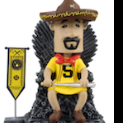
Brewers Video
The Brewers have put a significant emphasis in recent drafts and international signings on speed, defense, and prioritizing contact over power. Much of the growing talent in the minor leagues is at the lower levels, which along with the near-MLB ready talent at AAA Nashville, should provide the Brewers with a consistent influx of talent for years to come.
This optimism is supported by MLB.com player ratings about our new Top 30 rankings. Using the 20-80 grading scale, of all 30 MLB teams, the Brewers Top 30 prospects rank number one in both average Run (56.0) and Field grades (54.8). The average age of their Top 30 is also the fourth youngest at roughly 21 years, 4 months at the time the new rankings were released.
All of this emphasis on speed and defense is great in one way, but could create problems down the road when it comes to actually finding a permanent position for everyone. Positions that are generally thought of as being “power” positions, mostly your corner infield and outfield spots, could possibly be manned regularly by those with less power than what is traditional at the MLB level.
The outfield corners should actually be fine in the future, with right fielder Joey Wiemer providing excellent power potential (60-grade). Current center fielder, but likely left fielder in the future, Jackson Chourio also has well-above average power potential (also 60-grade). However, it’s the infield that may struggle to provide a lot of punch.
There are multiple options for center field in the future, including back-to-back first-round picks (and recently promoted) Garrett Mitchell (2020) and Sal Frelick (2021). Both excel across the board, especially with their speed (70-grade run for both) and defense (60-field for Mitchell, 55 for Frelick). However, Frelick (60-grade hit, 45-grade power) is projected to be a slightly better offensive threat than Mitchell (50-grade hit, 45-grade power). Regardless, the Crew looks set at center field for years to come.
Further down the rankings, outfielders Hendry Mendez (#15) and Hedbert Perez (#18), both at Low-A Carolina, and #28 Carlos Rodriguez, currently at High-A Wisconsin, also have a chance of contributing at the Major League level in the future. Becoming a starter ahead of the group in front of them may be difficult, but Rodriguez especially has the tools (50-hit, 60-run, 60-field) that may translate into a nice career as a bench player.
The Brewers’ lack of a true prototypical first or third base prospect in recent years has been well documented. There are currently zero players in the Top 30 playing either spot regularly. Despite this, with some creativity, there are some very good prospects in the system that may be quality candidates for these positions, even if they are currently playing at other positions.
There are a couple of candidates among our Top 30 prospects that I would like to see get an opportunity at first base in the future. The first of those is 2B Tyler Black. Our #6 prospect played solid infield defense both in college and so far as a pro, but he has a fairly weak throwing arm (45-grade) due to some shoulder injuries. With his good infield hands, his size (6’2”, 190 lbs.), and his well above-average bat-to-ball skills (60-grade hit), he should still produce enough both offensively and defensively at that position, even with his 45-grade power.
Another candidate that I would give a shot at first would be the aforementioned Mendez. Like Black, Mendez would also provide a good target at 1B (also listed as 6’2”), he throws left-handed (always an advantage at first base), and while he is already only a 45-grade runner now, he is expected to slow down even more as he ages. At 18 years old currently, (he turns 19 in November) and having a nice season at Low-A Carolina, there is plenty of time to teach our #15 prospect and his 55-grade hit, 50-grade power how to play first base adequately.
Third base could be a bit easier to find potential everyday players that fit the profile. This year’s first-round pick, Eric Brown Jr. should be a solid offensive producer (50-grade hit, power, and run), and good defensively no matter where on the infield he plays (55- grade field and throw). If he produces the way the Brewers envisioned when they drafted him 27th overall in July, he could be a solid third basemen at the Major League level.
With SS Wily Adames set at the Major League level for several years yet, #4 prospect and 2018 first-rounder shortstop Brice Turang will likely be shifted to second base starting next year, as he is ready to prove himself at the MLB level. Other middle infield options likely to contribute at some point include 2B Felix Valerio (#14), SS Freddy Zamora (#22), and this year’s Comp-B pick, IF Robert Moore (#17). There are many others at the lower levels that could continue to progress in the coming years and become legitimate Major League-caliber players as well.
Let me know what your thoughts are about the Brewers’ future in the outfield and infield. Next time, we’ll look deeper into the top pitching and catching prospects.
Think you could write a story like this? Brewer Fanatic wants you to develop your voice, find an audience, and we'll pay you to do it. Just fill out this form.
MORE FROM BREWER FANATIC
— Latest Brewers coverage from our writers
— Recent Brewers discussion in our forums
— Follow Brewer Fanatic via Twitter, Facebook or email









Recommended Comments
Join the conversation
You can post now and register later. If you have an account, sign in now to post with your account.
Note: Your post will require moderator approval before it will be visible.